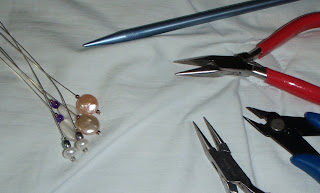If you are new to the party, please be sure to click on the "Summer Sampler" link at the bottom of this post, and start reading from the beginning! Today I am posting The Key. Consider this
page two of the project.
 The Key
The Key shows you the various symbols I am using on my charts, and gives a brief description of what knitting maneuvers you will need to do. There are some special moves, and I will cover them in detail when we get to the patterns that use them. I must say, right here, that we all knit differently. I give instructions for each maneuver, based on the typical American knitter that I meet when I teach. There are many ways to do each of these maneuvers. I am offering two very different but equally excellent links. I suggest you take a look at both if you have any questions about how a particular stitch should be dealt with:
For many of the moves, including the Double Vertical Decrease:
http://www.tata-tatao.to/knit/stitches/decrease/e-index.htmlAnd a link for a different way to work some of the moves:
http://fleeglesblog.blogspot.com/2006/12/slipping-and-sliding-go-away.htmlThe Summer Sampler study will result in a rectangular stole, if you choose to do the entire project. The construction is very straight-forward. We will start with a temporary cast-on and knit 12 different lace patterns, with a small spacer of faggoting between each pattern. As we do each pattern, there will be plenty of opportunity to play with your lace technique and try some interesting things. When we finish all 12 patterns, there will be an edging to knit around the entire piece and I will review various corner options.
Do you want to save the pattern? This is what I suggest if you use Microsoft Windows.
1) Open a new Word document.
2) Click on the
jpg to enlarge it.
3) Right-click on the enlarged
jpg.
4) Select “copy” from the dialogue box.
5) Paste the
jpg into the new Word file.
6) You may need to
re-size the
jpg by
-clicking on it,
-selecting “format”
-selecting “size”
-and making it smaller to fit the page if needed
You can add each page to the same file as I post them and print them from your file. There are many other good ways to do this, so do what works best for you. I don’t use Mac these days, so if someone has directions to do this on a Mac, please post them to the comments!
The next image shows an example of what my sampler charts will be like, with an explanation of my assorted numbers.

I trust this will help orient you to the charts. As an aside, the chart above is not one of the twelve we will be working for the sampler. It is another pattern. Make a swatch and tell me if you like it! Note that the chart for the study swatch will be yet another cute pattern that is not one of the twelve...I will post that next week!
Here is the yummy dinner we had. This is Spinach quiche, and I stuck to the
recipe, almost. I added one leek, one clove of garlic and a bunch of wild onions my daughter brought in from the backyard, all sauteed before adding the red pepper and the spinach. Four forks...

Eat, drink, knit and be happy...
 Might I suggest this fabulous, no-bake blueberry cheesecake? I made this for my sweetie's recent birthday, with extra berries, and it was wonderful...
Might I suggest this fabulous, no-bake blueberry cheesecake? I made this for my sweetie's recent birthday, with extra berries, and it was wonderful... By popular request, here is what pattern one looks like. This is my work, still on the needles. That means it is not blocked, but just pinned out for a picture. This is only an estimate of its final loveliness, because you all know what blocking does to fine lace knitting, right?
By popular request, here is what pattern one looks like. This is my work, still on the needles. That means it is not blocked, but just pinned out for a picture. This is only an estimate of its final loveliness, because you all know what blocking does to fine lace knitting, right? I thought I would also add a close-up of the spacer, also pinned out but un-blocked, for your reference.
I thought I would also add a close-up of the spacer, also pinned out but un-blocked, for your reference. Some of you might be wondering if all I am working on is that darn Summer Sampler. Certainly not! In truth, I am waaay out in front on the sampler, so I can swatch some new designs running from my head to my fingers. Below is one "swatch" so far. It should come off my needles later this weekend, so you will see this green item again soon.
Some of you might be wondering if all I am working on is that darn Summer Sampler. Certainly not! In truth, I am waaay out in front on the sampler, so I can swatch some new designs running from my head to my fingers. Below is one "swatch" so far. It should come off my needles later this weekend, so you will see this green item again soon. Until next time, knit on into June!
Until next time, knit on into June!








































